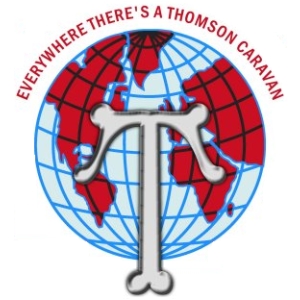|
| |
|
 |
 |
David Thomson
was re-organizing the factory just after the war, when Robin
Traill, the present sales director, joined the company. He
recalls, "My first impression was of a light and airy building,
more a joiner's shop than a factory." There was no such thing
as a production line. Caravans were being built alongside
the machine shop where the timber was cut. Painting was going
on near by. But the basic construction, using jigs, was the
same as today, though with less mechanization. There would
be 25 or 30 people on the floor, including Thomson father
and son.
"The output in 1946 sounds unimpressive at one-and-a-half caravans a week, say six a month. But everything was on ration, with the building industry crying out for materials and not much left for caravans by way of aluminium, plywood and steel for chassis."
The first post war models were the 14ft. 6in. Endrick and the 17ft. 6in.
Kelvin, replaced in 1949 by the super de luxe Kelvin Star, which cost £875. This had both gas and electricity plus a solid-fuel stove and water tanks. Unfortunately the Star was no greyhound, weighing about 25cwt. |
 |
The smaller Endrick scaled at least a ton, typical of the ratio of these days of l½ cwt. per linear foot.
It was in 1947 that Thomson decided to go in for the lightweight market.
This, incidentally, was the year when Thomsons (Carron) Ltd. was formed
with the responsibility-which it still has-of manufacturing caravans.
The Swift (8ft. 6in.), later renamed the Dart, was launched as a
6cwt. camping trailer costing £175. With light steel chassis, aluminium
skeleton members and panels, it was manufactured almost completely at
Carron. The rear end lifted up to form a canopy and inside were two berths
and folding table. The lightweight models lasted three years, being superseded
by a more conventional caravan that seemed better value at £185,
the 9ft. Carron (two-berth, end kitchen) with a delivered weight of only
10cwts.
In the 1949-50 season caravan production rose to 10 a week-to be precise
547, of which 190 were sold in Scotland , 345 in England , and a dozen
went for export.
In 1950 the Almond re-appeared, continuing with various improvements
up to the Mark VII, until in 1957 it evolved into the Glenalmond, the
name that has remained current. Up to that time all Thomson caravans
were called after Scottish rivers. The change to Glens coincided with
a significant change in Thomson design.
Through the 'fifties and beyond, Thomson always marketed one or two large
caravans of up to 22ft. They were capable of being towed, but were mostly
luxurious heavyweights, like the 1951 Braemar which scaled 36cwt. and
was essentially a residential caravan. |
|
| Reproduced from a 1970 publication by Thomson
T-Line Caravans Ltd called The "T-Line Story" |
|
|
|
|
|
|
|
| |
| |
 |
| |
Copyright © 1998 - 2015 Thomson T-Line History & Information |
|
| |
Disclaimer - The information provided on this Website site is offered with no warranty as to the authenticity, suitability or competence of the individual, company or service quoted here in. The Website shall not be liable for any damage or difficulty, direct or indirect, arising from utilization of the information contained within these pages. Thomson T-Line History & Information is not responsible for the content of external website's. |
|
| |



